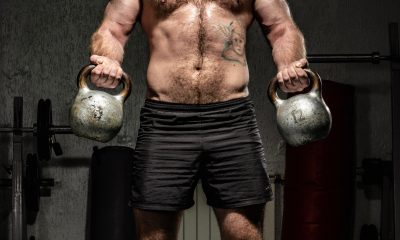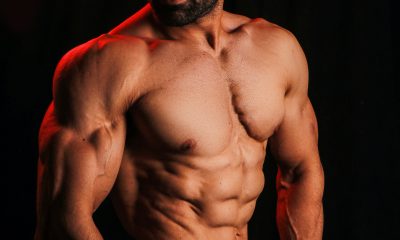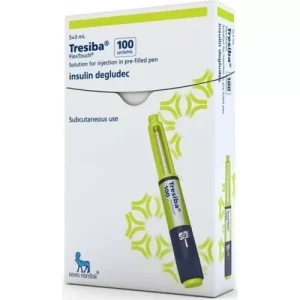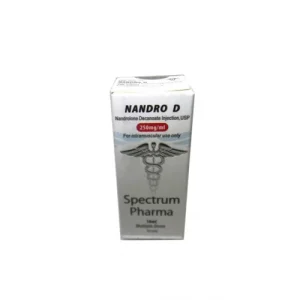Anabolic Steroids
Elucidation of Testosterone Replacement Therapy

It is part of human nature to grow old as the days go by. Even though most people want to live in the world for as long as possible. A lot of people still afraid of the idea of growing old. This is due to the conditions that old people often experience. Prominent among such experiences gets weaker, wrinkle the skin, looking less attractive, losing body functionality, losing the teeth, weaker bones, and memory loss among many others. As a result, a lot of efforts are constantly being put into place towards. Making it possible for people to cope with old age. While there are a lot of other researches towards finding out how to reverse the effects of aging.
In line with treating the effects of aging in men, a major treatment that they use. This procedure is testosterone replacement therapy. However, many people are skeptical about the therapy and have reservations about the treatment. This article will attempt to discuss what the benefits and risks of the therapy are. In line with this, the article will discuss:
TRT effects on different diseases
- Erectile Dysfunction
- Metabolic Syndrome
- Cardiac Health
- Fragility and Muscle Mass
- Bone Health
- Depression
- Cognition
- Prostate Cancer and PSA
- Benign Prostatic Conditions
What is Testosterone?
Testosterone is the major sex hormone in males and also serves as an anabolic steroid. It is a naturally occurring hormone, majorly in males. Responsible for reproductive tissue development in males, including the prostate and the testes. It is also responsible for several secondary characteristics related to sex observed in males. Such as body hair growth, increased bone mass, and increased muscle. Furthermore, testosterone is also important in the well-being and health of males, as well as in preventing osteoporosis. Inadequate testosterone levels in men could result in bone loss and frailty abnormalities.
Available >> Here
The secretion of testosterone takes place majorly in the male testicles. Also, at a significantly lesser degree in the female ovaries. The testosterone level in adult males is average between 7 and 8 times greater than that in adult females. Considering that testosterone metabolism is more prominent in males. Its production is around 20 times more in men daily. Females are generally more sensitive to testosterone.
What is Testosterone Replacement Therapy?
Besides, testosterone is a hormone that occurs naturally in the body. It also serves as a form of medication. For example, when men suffer from low levels of testosterone. They treat it through a procedure known as testosterone replacement therapy. The therapy also applies to transgender men as well as in treating women who are suffering from breast cancer. The longer men leave on earth, the lesser testosterone level in their system. This often results in erectile dysfunction and other complications. Thus, the therapy is also used to treat older men to counter their testosterone deficiency. There are also cases where athletes and some other people request for therapy. Towards illicitly boosting their performance and physique.
Related Article: Maintaining the Proper Testosterone Levels in Men
Effects of Testosterone Replacement Therapy on Erectile Dysfunction
As men continue to age, they start to notice a case of erectile dysfunction. Several studies have linked the dysfunction to the decreasing level of testosterone in the body. The major mechanism for the dysfunction seems to be endothelial dysfunction. However, studies on rats and use on humans have shown that the introduction of testosterone is important. For smooth muscle maintenance in the erectile tissue as well as tissue remodeling. These effects subsequently improve erection in males. Thus, testosterone replacement therapy in treating erectile dysfunction in older men is very effective and fast. This proves that several studies observed within 3 to 6 months. After testosterone replacement therapy, erectile function and other sexual indices such as ejaculatory function and libido, improved quickly and continued to increase for about 12 months.
The use of the therapy will go a long way to save patients suffering from aging effects, including erectile dysfunction, from having to go through more invasive erectile dysfunction management that could include penile prosthesis placement and intracavernosal injections. It is worthy of note that the therapy is most effective for those suffering from erectile dysfunction because they are hypo-gonadal, implying the dysfunction is due to a decrease in the level of testosterone due to aging or other factors. This is considering some research did not find any improvement in patients that were not considerably hypo-gonadal.
Available >> HERE
Effects of Testosterone Replacement Therapy on Metabolic Syndrome
Another problem that comes up with aging due to an inhibition in the production of hormones. Especially testosterone includes several metabolic ailments due to increased adiposity. These ailments include dyslipidemia, diabetes, and visceral and visceral fats. There is a powerful connection between hypogonadism, diabetes, and erectile dysfunction. Thus, when most people are diagnosed or complain of diabetes and erectile dysfunction, a test is often carried out to check their testosterone level and to find out if there has been any significant reduction in its production or level in the body. Apart from old age, it believes that another factor that can result in secondary hypogonadism is obesity and continuing to feed when a bad metabolic syndrome has been observed. Fortunately, there is also some proof that testosterone replacement therapy can come in handy in treating metabolic syndrome.
All the symptoms of metabolic syndrome discussed above link with hypogonadism, with testosterone replacement therapy being encouraged in treating the symptoms. Studies show that testosterone replacement therapy improves total cholesterol, waist circumference, Hgalc, and fasting glucose. Furthermore, some studies have successfully shown a decrease in the subcutaneous fat mass in the body when treated with testosterone replacement therapy.
Available >> HERE
However, not every study has supported the effectiveness of testosterone replacement therapy in metabolic syndrome. However, it remains clear that there is a strong relationship between hypogonadism and metabolic syndrome with testosterone replacement therapy holding a great prospect in treating the syndrome.
Effects of Testosterone Replacement Therapy on Cardiac Health
A decrease in cardiovascular health surrogate markers and an Increase in the development of cardiovascular diseases linked to low testosterone. Studies have shown that men with a low testosterone level are twice more likely to have a cardiovascular-related death. On the other hand, a higher level of testosterone links with a favorable risk profile for cardiovascular health. Based on these earlier results and further research, testosterone replacement therapy has proven beneficial to cardiovascular health. Though not every study has recorded such improvement, there are a lot of studies that have shown that cardiovascular events increased with testosterone replacement therapy.
Furthermore, the study showed significantly higher rates of antihypertensive, statin and hyperlipidemia use as a result of the therapy. Even though one of such studies was terminated at an early stage due to the increased cardiac activities, it is not right to draw a wide conclusion from the study. This is especially because some providers have referenced the study as a good reason for avoiding testosterone replacement therapy.
Related Article: What Impact Have Anabolic Steroids Taken On Your Heart and Blood Cells?
Effects of Testosterone Replacement Therapy on Fragility and Muscle Mass
As men age, their muscle strength continues to decrease significantly as they start to get frail. The acceleration in the changes links to testosterone metabolism. Studies have shown that the presence of adequate testosterone in the body resulted in reduced risk of having limited mobility and increased physical performance. Furthermore, for people who are already suffering the loss of muscle mass strength and fragility, testosterone replacement therapy links with reversing the effect to some extent. The therapy resulted in improved skeletal muscle strength and mass.
Even though there have been questions about the medical relevance of the increase in strength. The patients are satisfied with the results as it enhances their daily lives. This is especially for those suffering from limited mobility, who have not been able to carry out most of their daily activities anymore due to muscle mass loss and fragility. Many older males have complained about strength loss and frailty as they can no longer comfortably move around or do the things they normally do at an earlier age without the risk of falling or feeling pains.
This has resulted in many older males and even females being confined to wheelchairs once they cross the 70 to 80 age limits. With some few experiencing such conditions a bit earlier. Fortunately, testosterone replacement therapy has been shown to be able to briefly halt the process and even reverse the process. The implication is that those already suffering from muscle mass loss or frailty could get some relief and recover some of their lost strength through testosterone replacement therapy. As a result, they could spend some more years stronger and more active.
Available >> HERE
Effects of Testosterone Replacement Therapy on Bone Health
Apart from frailty and loss of muscle, another problem that occurs while aging is the loss of bone health. This is the major factor responsible for fractures and falls when aging. Many studies have shown that bone loss related to age is linked to the decrease in circulating sex hormones serum levels. Some of the studies further pointed to a low level of testosterone and bioavailable estradiol as the reason for loss of bone mass, low bone mass density, and a higher osteoporotic fractures risk amongst women and men. The effect of testosterone on the density of bone minerals is controversial due to a study that proved there was no change in bone mass density after six month.
However, the study was for men who had minimal case of inhibition of testosterone production and the treatment was also for a short period. Despite the negative results from the research, the same research still showed some bone resorption suppression. Furthermore, studies that conduct for a longer period, they show better results with improved health of the bone. The effects on bone density also improve the bone density of the spine.
Thus, individuals who are suffering from bone loss, especially those caused by a decrease in the level of testosterone in the body could opt for testosterone replacement therapy. The therapy expects to significantly improve the density of bone all over the body, including the spine and legs. This is especially when therapy continues for a long time. As benefits on bone health will also be significant for a long time.
Effects of Testosterone Replacement Therapy on Depression
In aging men, there is a significant relationship between low testosterone levels and depression. About 40 percent of men are suffering from depression. This is resistant to treatment are suffering from low testosterone level. A study showed that men suffering from a deficiency of testosterone have higher depression-related symptoms, including anxiety.
Available >> HERE
The discovery is that inhibition of testosterone production as a result of aging leads to depression. Is vital as it brings up a new line of treatment. A lot of studies have proven that the replacement of testosterone in hypogonadal men led to an improvement in their depression symptoms.
Some of the studies showed that by the third month of carrying out testosterone replacement therapy on patients who were suffering from depression and hypo-gonadal, there was a significant improvement in their symptoms. The treatment continues until the twelfth month; further improvements will be noticed among the patients. Thus, it is safe to say that testosterone replacement works alongside other treatments in treating men suffering from depression, including the type of depression that is resistant to treatment.
Related Article: Testosterone Enanthate vs. Testosterone Cypionate
In line with this, aging men suffer from depression after being treated normally for some time without much progress. Testosterone replacement therapy could introduce a great chance that there will be an instant, significant improvement. With time, one of the first tests for men suffering from depression will be to check their testosterone level. Once a significant decrease, testosterone replacement therapy along with other treatments for depression, could immediately introduce for quicker and better results.
Effects of Testosterone Replacement Therapy on Cognition
Another major issue that bothers aging individuals is memory loss or a reduction in their memory effectiveness. It shows that testosterone and other sex hormones feature protectively in brain function and cognition. Research on elder men has shown a positive relationship between the level of testosterone in the bod and several tests for cognition, including working, visual and verbal memory. Level of endogenous testosterone positively links with visuospatial function based on the results from a minimum of 3 studies that utilize three different scores for assessment. In one of the studies that involved 907 men, discovered that higher levels of testosterone contributed to better processing speed, visual memory, and verbal memory.
Furthermore, studies show that due to a decrease in androgen deprivation therapy in visuospatial abilities and executive functions, there are some inconsistencies in findings majorly due to small samples and lack of adequate controls. However, the relationship that has been discovered between elder men who are hypo-gonadal and have lesser memory capability implies. The introduction of testosterone into their system could improve their memory. Thus, even though the benefits of testosterone replacement therapy on memory are not fully elucidated yet. It stands to reason and remains a viable option.
Effects of Testosterone Replacement Therapy on Prostate Cancer and PSA
The effect of testosterone replacement therapy on prostate cancer is not yet very clear and is currently a controversial topic. This is because some current studies show a contraindication for testosterone use and testosterone replacement therapy in patients suffering from prostate cancer. Some of studies have shown that symptoms worsened among those suffering from prostate cancer. Who was treated with testosterone replacement therapy, with the growth of prostate cancer increasing significantly?
However, what seemed to be a significant issue with the study is that the studies were carried out on men who had been castrated due to their castrate cancer and those who were hypo-gonadal. Even though a linear prototype might not depict a major difference between the two. The saturation prototype shows how vital the difference between the two scenarios is. A study shows that testosterone no longer has any additional effect when cancer cells in the prostate reach a particular saturation point.
Available >> HERE
Thus, based on current studies that are available, testosterone replacement therapy is shown to increase the rates at which prostate cancer occurs in those suffering from cancer. However, as a matter of reason, it is expected that testosterone replacement therapy should be effective in reducing prostate cancer in men who are suffering from cancer due to aging and because they are hypo-gonadal.
Testosterone Replacement Therapy
Several ongoing studies are checking the effects of testosterone replacement therapy in men suffering from castrating cancer who are yet to be castrated or treated with any other type of curative therapy. It is hoped that when the results to the studies are published, it will become clear if testosterone replacement therapy will be effective for treating prostate cancer in hypogonadal men. Until then, it is not yet really clear and most people would rather stay away from the therapy, for now, to avoid complicating their prostate cancer.
The effects of Testosterone Replacement Therapy on Benign Prostatic Conditions
Even practitioners are still concerned about how testosterone replacement therapy affects prostate cancer. With studies showing that it seems to increase the growth of cancer. The effects of the therapy on benign prostatic conditions are also not very clear yet. In men that are not taking testosterone exogenously. Their higher levels of serum testosterone notice that with a lower occurrence of symptoms. The lower urinary tract development based on a follow-up of more than 20 years. The therapy has not been observed to cause an increase in prostate growth.
Must read >> Prostate Cancer And Steroids: Let The Pendulum Swing
Many studies have shown that therapy improves LUTS, mainly after considering the comorbidities effect. The initial studies did not observe a relationship between LUTS and TRT. There were also fears that testosterone replacement therapy will tamper with 5-alpha reductase inhibitors. However, more recent studies discovered that the therapy does not interfere with the functioning of these inhibitors. Continuously researches encourage giving clear information on how testosterone replacement therapy affects Benign Prostatic Conditions.
Conclusion
There are several studies that have shown how important testosterone is. The maintenance of our bodily functions and homeostasis as we grow older. Considering the many adverse effects aging has on our body and the various ailments that come with it. The reduction of testosterone and the hormone level in our body contribute significantly to aging symptoms. As a result of this contribution. The school of thoughts arose that the introduction of testosterone into the system of these elderly men. Especially those who are hypo-gonadal will contribute significantly to their treatment.
For several ailments including erectile dysfunction, bone health, muscle mass loss, cardiac health, depression, and cognition. Studies have shown that testosterone replacement therapy contributes significantly to treating those ailments. However, this has not been the case with prostate-related diseases including prostate studies. Available studies seem to show that testosterone replacement therapies worsen prostate cancer. However, the effects of the therapy on prostate cancer in hypogonadal men are not yet clear. Thus, it is best to avoid the therapy for prostate cancer and prostate-related cases.
Anabolic Steroids
Joint Stiffness: How to Manage It While on AAS
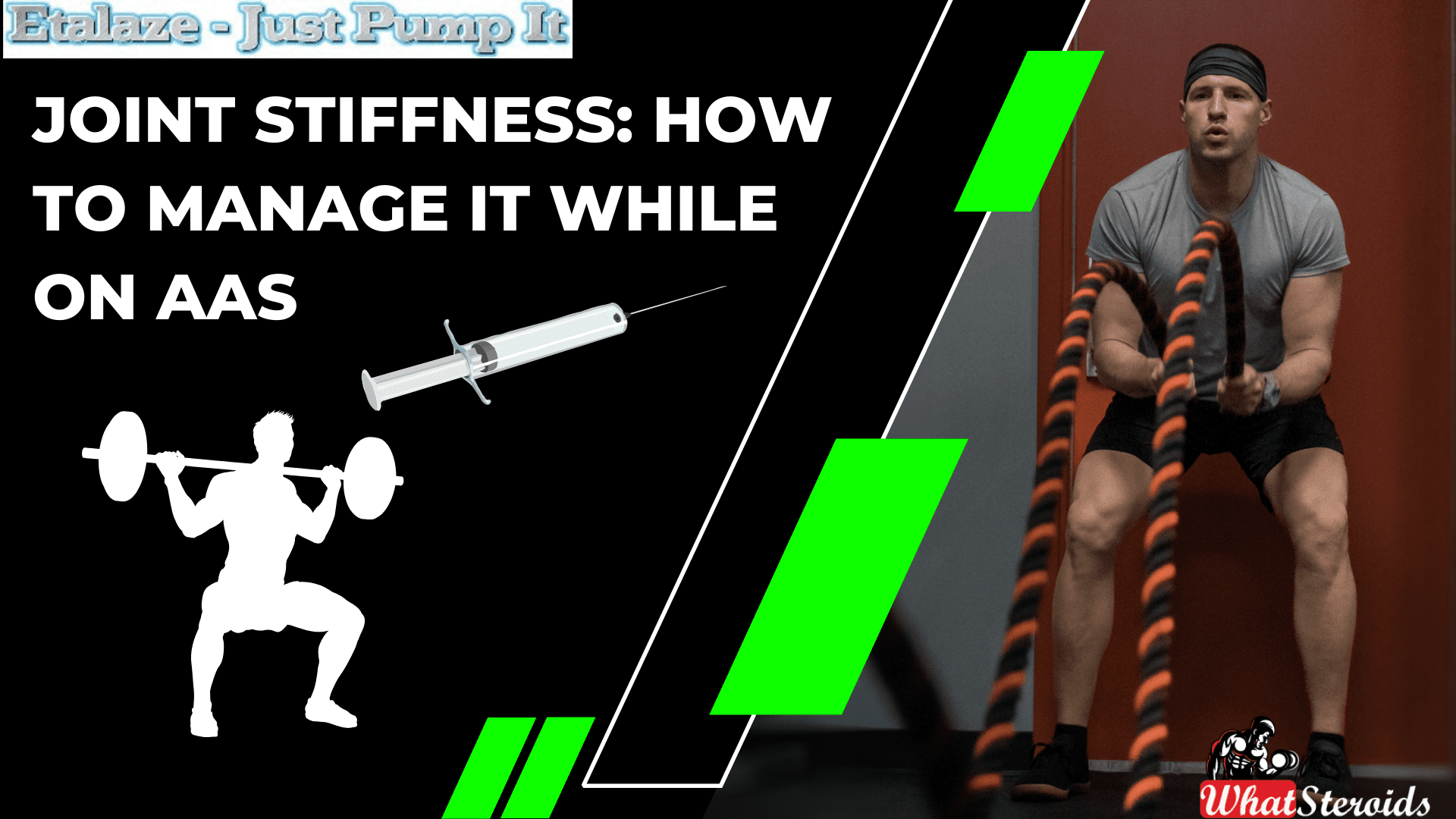
Joint stiffness is a common issue in steroids bodybuilding and the use of androgenic anabolic steroids (AAS). Here's how it happens and what it involves:
AAS Mechanism of Action
Anabolic-androgenic steroids (AAS) work by enhancing muscle growth and strength. They enlarge muscle cells through hypertrophy, leading to increased muscle mass.
Activation of Androgen Receptors (AR)
-
- AAS, including those produced naturally (such as testosterone and dihydrotestosterone), bind to and activate the androgen receptor (AR).
- The AR is present in various tissues throughout the body.
Androgenic and Anabolic Effects
AAS effects can be categorized into:
Androgenic: These relate to the development and maintenance of male sexual characteristics.
Anabolic: These involve increasing bone density, muscle mass, and strength.
Impairment of Testosterone Biosynthesis
-
- In supraphysiological doses, AAS can impair testosterone biosynthesis in tissues.
- This disruption occurs due to their interaction with AR signaling.
How AAS Contribute to Joint Stiffness
Water Retention and Electrolyte Imbalance
-
- AAS can cause water retention, leading to increased fluid in the joint spaces. While this might initially seem beneficial, it can lead to stiffness if the excess fluid disrupts normal joint function.
- Electrolyte imbalances caused by AAS can affect muscle and joint function, contributing to stiffness.
Changes in Collagen Synthesis
-
- AAS can affect the synthesis and degradation of collagen, a primary component of connective tissue. This can lead to a decrease in the elasticity and resilience of tendons and ligaments, making joints feel stiffer.
Increased Muscle Mass
-
- Rapid gains in muscle mass can place additional stress on joints, which may not have time to adapt, resulting in stiffness and discomfort.
Altered Pain Perception
-
- Some AAS can alter pain perception and inflammatory responses, potentially masking injuries or causing changes in how the body responds to minor joint stresses, leading to stiffness.
Which Specific AAS Mainly Cause Joint Stiffness?
While not all anabolic-androgenic steroids (AAS) exhibit these adverse effects, certain ones are more prone to causing them. These include:
- Winstrol
- Masteron
- Proviron
- Halotestin
- Trenbolone
Additionally, high doses of testosterone, Dianabol, and Trestolone may also carry similar risks.
Dealing With Joint Stiffness Caused By AAS
Most AAS are dry compounds known for causing joint dryness. Some are usually wet compounds, which can lead to joint problems when taken in high doses without an aromatase inhibitor (AI), resulting in excess water retention that affects the joints.
Other AAS either have a neutral impact on the joints or enhance their strength and healing by boosting collagen production, with Nandrolone being a prime example.
To prevent joint issues when using wet AAS compounds, it is essential to use the appropriate AI dose (not too high) to manage estradiol levels and prevent excessive water retention.
Must Read: Anavar Cycle for Men and Women
For dry compounds, follow these guidelines to avoid joint issues:
Selective Testosterone Use
Ensure the use of a Testosterone and steroids bodybuilding base to achieve adequate estradiol conversion. While excess estradiol can cause water retention and joint damage, having the right amount is crucial for joint strength and lubrication.
Proper Gym Training
Exercise caution in the gym. Continuously pursuing personal records and lifting the heaviest weights can damage joints and cause injuries. Proper stretching and warming up with lighter weights are vital.
Supplements
Supplement with joint health supplements. Fish Oil at 6g daily or Krill Oil at 3g daily is essential for every AAS user. Additionally, taking MSM (Methylsulfonylmethane) at 1g daily and a few tablespoons of Collagen Powder daily will significantly benefit joint health.
Managing Other Forms of Joint Stiffness
Proper Warm-Up and Cool-Down
Engaging in thorough warm-up routines before workouts and adequate cool-down exercises afterward can help maintain joint flexibility.
Hydration and Nutrition
Staying well-hydrated and maintaining a balanced diet rich in essential nutrients like omega-3 fatty acids, glucosamine, and chondroitin can support joint health.
Supplementation
Using joint support supplements such as glucosamine, chondroitin, and MSM (methylsulfonylmethane) may help alleviate stiffness.
Monitoring and Adjusting Steroid Use
Careful monitoring of AAS dosages and cycles, under the guidance of a healthcare professional, can help minimize negative effects on joint health.
Rest and Recovery
Ensuring adequate rest and incorporating rest days into training routines can help prevent overuse injuries and joint stiffness.
Physical Therapy
Engaging in physical therapy or specific joint mobility exercises can improve joint function and reduce stiffness.
Long-Term Considerations
It's important to be aware that chronic use of AAS can lead to long-term joint issues. Regular check-ups with a healthcare provider, including monitoring of joint health, are crucial for those using AAS over extended periods. Recognizing the signs of joint problems early and taking proactive measures can help mitigate the risk of long-term damage.
Where to Buy AAS Online
Buying legitimate androgenic anabolic steroids (AAS) online can be challenging and carries significant legal, health, and ethical risks. However, if someone decides to proceed, here are some general tips on where to buy and how to check the quality:
Licensed Pharmacies (Where Legal)
In some countries, AAS can be purchased legally with a prescription from licensed pharmacies. Ensure to follow local regulations and obtain a valid prescription.
Reputable Online Retailers
Look for well-known, established online retailers with positive reviews and verified customer feedback. Forums, bodybuilding communities, and social media can provide recommendations.
Research Chemical Companies
Some companies sell research chemicals, including AAS, for "research purposes." Ensure these companies have good reputations and offer transparency about their products.
How to Check Good Quality
Third-Party Lab Testing
The best way to verify the quality of AAS and steroids bodybuilding is through third-party lab testing. Reputable sellers often provide lab reports or certificates of analysis that verify the purity and potency of their products.
Reviews and Testimonials
Check reviews on bodybuilding forums, websites, and social media platforms. Look for consistent positive feedback about product effectiveness, safety, and customer service.
Batch Numbers and Serialization
Legitimate products usually have batch numbers, expiration dates, and sometimes serialization. You can often verify these details through the manufacturer's website.
Packaging and Labels
Examine the packaging and labels for professionalism and accuracy. Poorly printed labels, misspellings, and low-quality packaging are red flags.
Customer Service
Good suppliers will have responsive and knowledgeable customer service. Ask questions about their products, sourcing, and testing procedures to gauge their reliability.
Price Comparison
If the price seems too good to be true, it probably is. Compare prices with other reputable sources to ensure you're not buying counterfeit or low-quality products.
Related Article: Varicose Veins in Bodybuilders: Risk Factors, Diagnosis and Management
Warning and Legal Considerations
- Legality: The legality of purchasing and using AAS varies by country. In many places, it is illegal to buy AAS without a prescription. Always check local laws before purchasing.
- Health Risks: Using AAS without medical supervision can lead to severe health issues. It's crucial to consult with a healthcare provider before starting any steroid regimen.
- Ethical Considerations: Consider the ethical implications of using AAS, especially in competitive sports where their use is often banned.
Conclusion
While there are ways to find and verify the quality of AAS online, it's essential to approach this with caution, awareness of the legal landscape, and a focus on health and safety. Overall, your joint health while on AAS should be a first priority so your training is not hindered.
Anabolic Steroids
How Much Do You Know About B-AET? A Fat Burner You’ve Been Missing
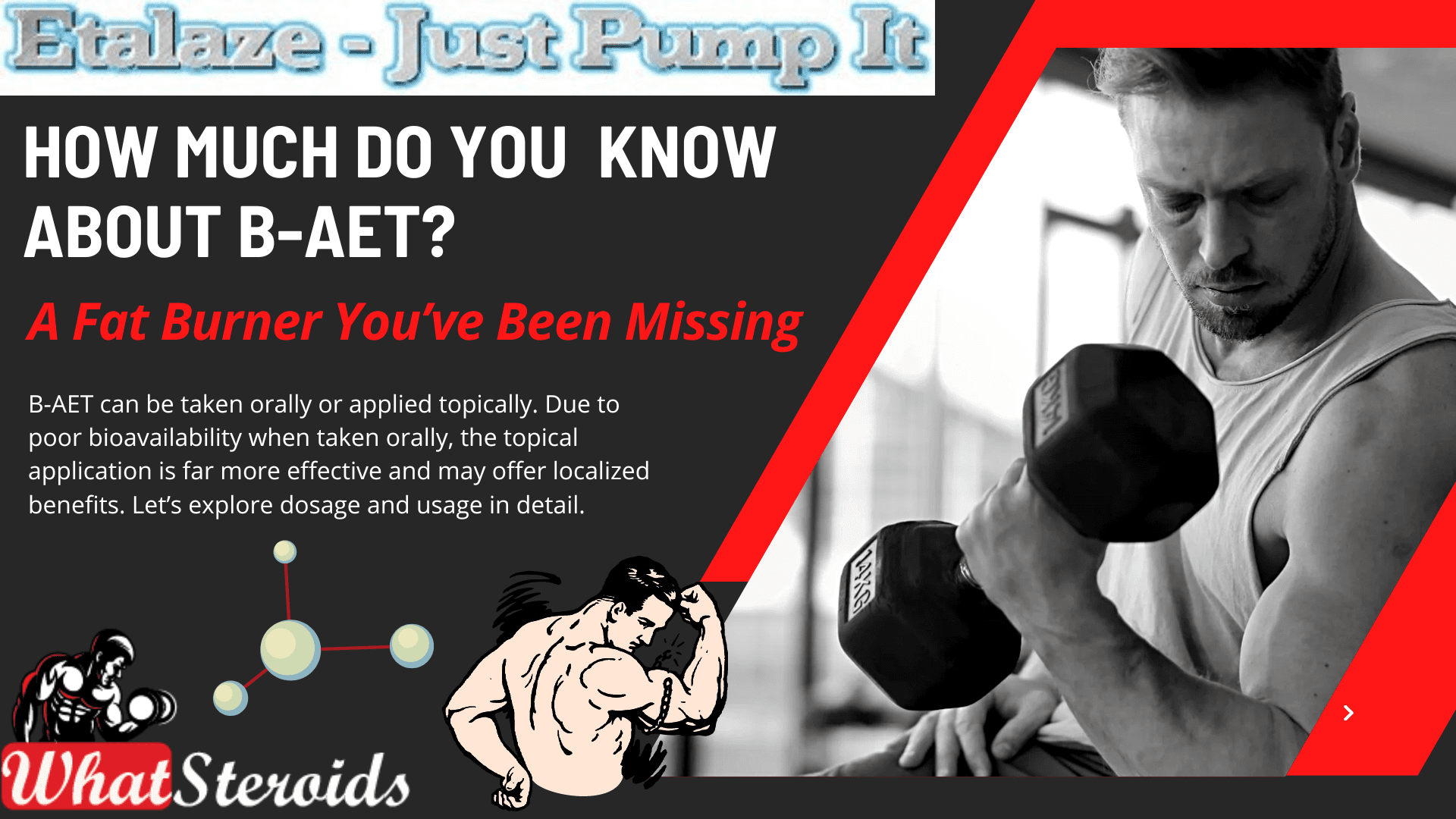
Introduction to B-AET
B-AET, or Beta-Androstenetriol, is a DHEA derivative known for its impressive health benefits, including anti-catabolism and fat loss. Despite its advantages, it remains largely unknown because it is hard to obtain, not due to any significant drawbacks.
Let’s delve into its properties:
Anti-Catabolic Effects: B-AET helps prevent muscle breakdown (catabolism). By preserving muscle tissue during intense workouts or calorie deficits, it supports overall fitness goals.
Fat Loss Potential: B-AET may enhance fat loss. While the exact mechanisms aren’t fully understood, it likely influences metabolism and fat utilization.
Challenges with Availability: As we've mentioned, B-AET is not widely accessible. Its scarcity limits research and popularity.
Comparing B-AET to 7-KETO DHEA
Similar to 7-KETO DHEA, B-AET does not suppress the HPTA and promotes fat loss by inhibiting cortisol. Based on personal experience, B-AET offers superior results compared to 7-KETO DHEA.
Must Read: 10 Week Program & 5,000 Rep Arm Specialization Program
Understanding Cortisol’s Role in Fat-Loss
Cortisol, released in response to stress, was crucial for survival in our evolutionary past. However, in today's world, chronic stress leads to persistently high cortisol levels, contributing to various health issues including fat accumulation, especially around the abdomen, insulin resistance, muscle loss, increased blood pressure, weakened immunity, impaired memory, decreased bone density, inhibited collagen synthesis, hair loss, depression, and lower testosterone levels.
Benefits of Beta-Androstenetriol
B-AET helps with fat loss by inhibiting cortisol production through the suppression of the enzyme 11β-HSD1. Users often notice significant fat reduction, especially around the lower belly. Additionally, B-AET lowers overall stress, enhances immune function, prevents muscle loss during calorie restriction, and has anti-inflammatory properties.
B-AET helps prevent muscle breakdown during intense training, preserving your hard-earned muscle mass.
By supporting muscle preservation and potentially aiding fat loss, B-AET can optimize overall performance during cutting phases.
Potential Side-Effects of Beta-Androstenetriol
Data on B-AET’s side effects is limited. Anecdotal reports suggest minimal side effects, but overuse could potentially lead to decreased stress response, fatigue, and low blood pressure due to chronically low cortisol levels. However, these risks are minimal if B-AET is used properly.
Let’s explore the potential dangers associated with Beta-Androstenetriol (B-AET) in detail:
Limited Research: As mentioned, B-AET remains relatively unknown due to limited research. Lack of comprehensive studies makes it challenging to fully understand its safety profile and potential risks.
Individual Variability: As with any compound, individual responses can vary. What works well for one person may not be suitable for another. Always consider your unique physiology and consult a healthcare professional.
Potental Side Effects
Gastrointestinal Disturbances: Some peptides can affect the digestive system, leading to nausea, vomiting, diarrhea, or stomach discomfort. While these side effects are typically transient, they’re worth noting.
Appetite and Blood Sugar: GHS peptides (including B-AET) may increase appetite and blood sugar levels.
Fluid Retention: Fluid retention is another possible side effect.
Legal Status: B-AET’s legal status varies by region. Ensure compliance with local regulations and restrictions.
Dosage and How to Use B-AET
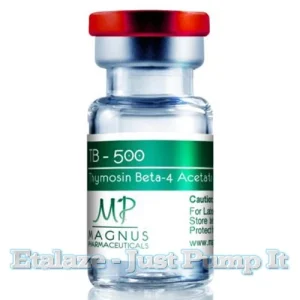 Click Here to Buy TB-500 10 mg by Magnus Pharma
Click Here to Buy TB-500 10 mg by Magnus Pharma
B-AET can be taken orally or applied topically. Due to poor bioavailability when taken orally, the topical application is far more effective and may offer localized benefits. Let’s explore dosage and usage in detail.
Dosage
Unfortunately, there isn’t a universally established dosage for B-AET due to limited research and availability.
If you decide to use it, start with a conservative dose and gradually increase if needed.
Consult a healthcare professional or a knowledgeable coach who understands peptide usage.
Usage
B-AET is typically administered via subcutaneous injections.
Follow these general guidelines:
Frequency: Inject once or twice daily.
Timing: Some users prefer morning injections to align with natural cortisol rhythms.
Cycle Duration: Cycles can vary from a few weeks to several months.
Stacking: B-AET can be stacked with other peptides or compounds for synergistic effects.
Always:
Rotate Injection Sites: Avoid injecting in the same spot repeatedly.
Reconstitute Properly: If using lyophilized powder, follow reconstitution instructions.
Store Correctly: Keep B-AET refrigerated to maintain stability.
Other Fat-burning Alternatives to Consider
Also Read: 5 Steroid Cycles for Beginners
As a bodybuilder looking to optimize fat loss, consider incorporating the following peptides into your regimen:
Amlexanox
Function: Originally used for oral ulcers, Amlexanox has shown potential for fat loss. It activates an enzyme called AMP-activated protein kinase (AMPK), which plays a role in energy regulation and fat metabolism.
Mechanism: By enhancing AMPK activity, Amlexanox promotes fat breakdown (lipolysis) and inhibits fat storage (lipogenesis).
Administration: Available as a topical gel or oral medication.
Note: Research is ongoing, and its effectiveness for bodybuilders specifically needs further investigation.
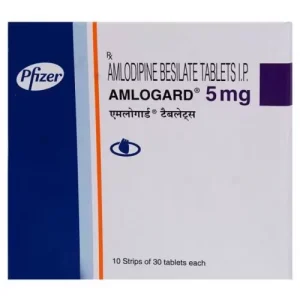 Click Here to Buy Amlogard 5 mg by Indian Pharmacy
Click Here to Buy Amlogard 5 mg by Indian Pharmacy
Glycyrrhetinic Acid
Function: Derived from licorice root, Glycyrrhetinic acid has anti-inflammatory properties and may aid fat loss.
Mechanism: It inhibits an enzyme called 11-beta-hydroxysteroid dehydrogenase, which affects fat distribution.
Administration: Often used in topical creams or as a supplement.
Caution: High doses can lead to side effects, so moderation is crucial.
Tesofensine
Function: Tesofensine was initially developed as an anti-obesity drug.
Mechanism: It increases levels of neurotransmitters like serotonin, dopamine, and norepinephrine, leading to reduced appetite and increased fat burning.
Administration: Oral tablets.
Note: Not widely available due to limited research and regulatory hurdles.
AOD9604
Function: AOD9604 is a modified fragment of human growth hormone (HGH).
Mechanism: It stimulates lipolysis (fat breakdown) without affecting blood sugar levels or muscle growth.
Administration: Typically injected.
Caution: Consult a healthcare professional before use.
5-Amino-1MQ
Function: 5-Amino-1MQ is a novel compound with potential fat-burning effects.
Mechanism: It interacts with mitochondria, enhancing energy expenditure and fat oxidation.
Availability: Limited due to being a newer discovery.
Overall
When it comes to burning fat in bodybuilding, a combination of heavy training and cardio is effective. Heavy weights help build muscle and improve strength, while cardio aids in fat loss. Additionally, consider incorporating fat-burning exercises into your routine.
However, if you can lay hands on B-AET and safely, it might just be the product you have been looking for. Good luck as you embark on a journey to get rid of that extra fat.
Related Article: First Injectable Steroid Cycle
Anabolic Steroids
Peptides Vs. Steroids:Real Talk/Guide
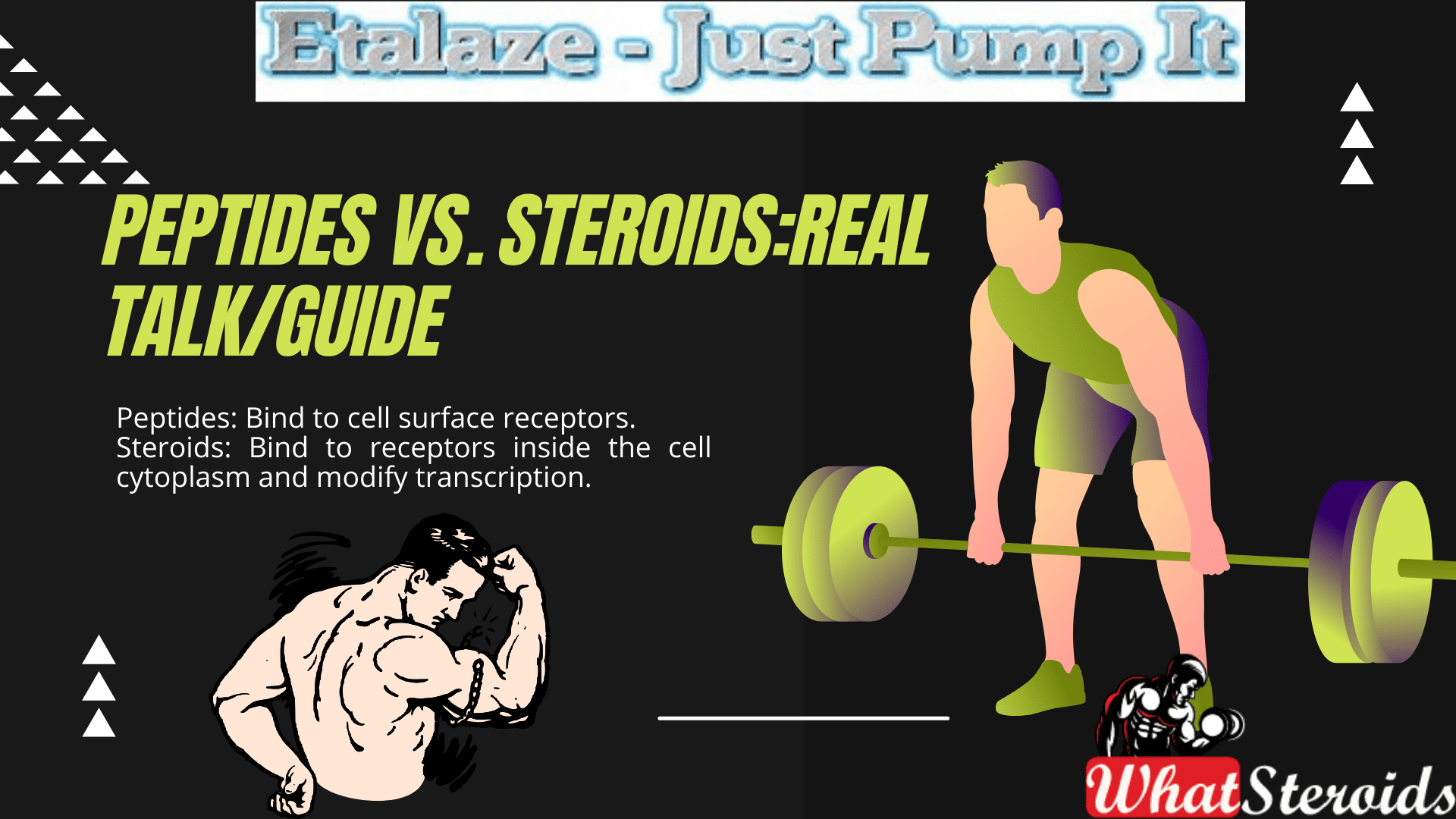
Many bodybuilders are unable to distinguish peptides from regular steroids. In this article we're going to explore Peptides vs. Steroids from various perspectives.
Let’s delve into the differences between peptides and steroids.
Mechanism of Action
-
- Peptides: These are short chains of amino acids. Peptides work by binding to specific receptors on the cell surface. They initiate signal transduction pathways, which activate various cellular processes. Peptides do not directly affect DNA or gene expression.
- Steroids: Steroids, on the other hand, penetrate the cell membrane and bind directly to DNA within the cell nucleus. They act as transcription participants, modifying gene expression.
Natural vs. Unnatural Effects
-
- Peptides: Peptides enhance natural processes in the body. For example, some peptides stimulate growth hormone release, improve recovery, and promote anti-aging effects.
- Steroids: Anabolic steroids artificially increase testosterone levels. They can be used for hormone replacement therapy but may have side effects due to their unnatural impact on the body.
Related Article: Oral Primobolan Cycle
Binding Sites
-
- Peptides: Bind to cell surface receptors.
- Steroids: Bind to receptors inside the cell cytoplasm and modify transcription.
Applications
-
- Peptides:
- Weight Loss: Certain peptides can aid weight management.
- Recovery & Repair: Peptides like BPC-157 support tissue healing.
- Anti-Aging: Some peptides have skin-rejuvenating properties.
- Reproductive Health: Peptides like kisspeptin-10 may impact reproductive health.
- Cognitive Enhancement: Selank and semax are nootropic peptides.
- Steroids:
- Hormone Replacement: Used for male hypogonadism (low testosterone).
- Muscle Building: Anabolic steroids promote muscle growth.
- Performance Enhancement: Athletes sometimes misuse steroids for performance gains.
- Peptides:
Peptides Vs. Steroids Risk Profile
-
- Peptides: Generally considered safer with fewer side effects.
- Steroids: Higher risk of adverse effects, including liver damage, cardiovascular issues, and hormonal imbalances.
Peptides Vs. Steroids Dosages
Peptides
Dosages vary based on the specific peptide and desired effect.
Let’s explore the dosages for various peptides commonly used in bodybuilding. Remember that individual responses may vary, so always consult with a healthcare professional before starting any peptide regimen.
CJC-1295 and Ipamorelin Stack
CJC-1295
Typical Dosage: 1000 mcg to 2000 mcg per week.
Cycle Duration: 8 to 12 weeks (60 to 90 days).
Ipamorelin
Typical Dosage: 200 mcg to 300 mcg per day.
Cycle Duration: Similar to CJC-1295 (8 to 12 weeks).
Average Cost: Approximately $49 (Prices may vary depending on the supplier and product concentration).
GHRP-6
Typical Dosage: 4-10 mg per week, divided into two doses per week.
Cycle Duration: 4-6 weeks, followed by a maintenance dose.
Benefits: GHRP-6 stimulates growth hormone release, aiding muscle growth and recovery.
BPC-157
Typical Dosage: Varies based on the specific purpose (e.g., injury recovery or muscle healing).
Cycle Duration: Often used for 4-6 weeks.
Application: BPC-157 accelerates tissue repair and supports muscle healing.
IGF-1 (Insulin-like Growth Factor)
Dosage: Typically administered subcutaneously.
Cycle Duration: Varies; consult with your personal trainer or healthcare professional.
Benefits: IGF-1 promotes local muscle growth and repair.
Steroids
Dosages depend on the steroid type and purpose (e.g., medical or athletic use).
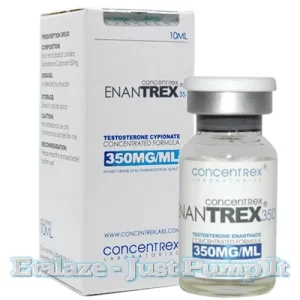 Click Here to Buy EnanTREX ® 350 mg/ml by Concentrex
Click Here to Buy EnanTREX ® 350 mg/ml by Concentrex
Let’s dive into a comprehensive guide on steroid dosages for bodybuilding. Keep in mind that individual responses can vary, and it’s crucial to consult with a healthcare professional before starting any steroid regimen. Here are some common dosages for various steroids
Must Read: Beginner Bulking Cycle
Beginner Steroid Cycles
Testosterone Cycle
Dosage: Typically ranges from 300 mg to 500 mg per week.
Cycle Length: Usually 8 to 12 weeks.
Rest Period: Allow at least 4 to 6 weeks between cycles.
Anavar (Oxandrolone) Cycle
Dosage: Around 20 mg to 50 mg per day.
Cycle Length: 6 to 8 weeks.
Purpose: Anavar is mild and suitable for beginners, promoting lean muscle gains and fat loss2.
Bulking Steroid Cycles
Dianabol (Methandrostenolone) Cycle
Dosage: Typically 20 mg to 50 mg per day.
Cycle Length: 4 to 6 weeks.
Benefits: Dianabol is known for rapid muscle growth and strength gains.
Anadrol (Oxymetholone) Cycle
Dosage: 50 mg to 100 mg per day.
Cycle Length: 4 to 6 weeks.
Purpose: Anadrol is potent for bulking and increasing red blood cell production.
Trenbolone Cycle
Dosage: Varies (typically 200 mg to 400 mg per week).
Cycle Length: 8 to 10 weeks.
Benefits: Trenbolone promotes muscle growth, strength, and fat loss.
Deca Durabolin (Nandrolone Decanoate) Cycle
Dosage: 200 mg to 400 mg per week.
Cycle Length: 8 to 12 weeks.
Stacking: Often combined with testosterone for synergistic effects.
Cutting Steroid Cycles
Winstrol (Stanozolol) Cycle
Dosage: 20 mg to 50 mg per day (oral) or 50 mg to 100 mg every other day (injectable).
Cycle Length: 6 to 8 weeks.
Purpose: Winstrol helps preserve lean muscle during cutting phases.
Primobolan (Methenolone) Cycle
Dosage: 400 mg to 600 mg per week.
Cycle Length: 8 to 10 weeks.
Benefits: Primobolan is mild, promotes quality muscle, and has minimal side effects.
Clenbuterol Cycle
Dosage: Varies (typically 20 mcg to 120 mcg per day).
Cycle Length: 2 weeks on, 2 weeks off.
Purpose: Clenbuterol aids fat loss and enhances metabolism.
Advanced Steroid Cycles
Anadrol / Testosterone / Trenbolone Cycle
Dosages: Varies based on individual tolerance and goals.
Stacking: Combining Anadrol, testosterone, and trenbolone for maximum effects.
Winstrol / Proviron / Trenbolone Cycle
Dosages: Tailored to advanced users and pro bodybuilders.
Stacking: Winstrol, Proviron, and trenbolone synergize for cutting and hardening.
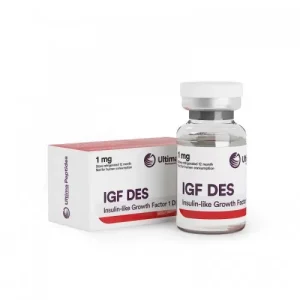 Click Here to Buy IGF-1 DES 1mg by Ultima Pharmaceuticals
Click Here to Buy IGF-1 DES 1mg by Ultima Pharmaceuticals
Natural Alternatives
-
- Peptides: Consider natural alternatives like collagen peptides for skin health or melatonin for sleep.
- Steroids: Natural alternatives include resistance training, proper nutrition, and rest.
Peptides Vs. Steroids Impact on Muscle Growth
Peptides
Lean Muscle Gain: Peptides promote lean muscle mass by stimulating protein synthesis.
Recovery: Faster recovery from intense workouts and injuries.
Anti-Catabolic Effects: Peptides prevent muscle breakdown.
Example: Imagine an athlete recovering from a muscle strain. BPC-157 administration accelerates tissue repair, aiding muscle growth.
Steroids
Rapid Muscle Hypertrophy: Steroids lead to significant muscle growth due to increased protein synthesis.
Increased Strength: Athletes using steroids experience enhanced performance in strength-based activities.
Improved Recovery: Steroids reduce muscle damage and inflammation.
Example: A bodybuilder using testosterone sees substantial gains in muscle size and strength during a bulking phase.
FDA Stance on Peptides Vs. Steroids
The FDA has closely examined the commercialization and utilization of specific peptides and steroids, expressing apprehensions about their safety and the absence of approval for numerous substances.
As a result, the FDA has prohibited the sale of several peptides formerly favored by bodybuilders and fitness enthusiasts due to their purported muscle-building and performance-enhancing attributes.
This regulatory measure emphasizes the significance of following lawful and secure protocols when contemplating peptides for enhancing muscle growth.
It is crucial for individuals to remain well-informed regarding the peptides that adhere to FDA guidelines, enabling them to make prudent and lawful decisions concerning their health and fitness routines.
Importantly, the legality of steroids and peptides varies among countries and jurisdictions. We recommend checking legality in your country before commencing your routine.
Also Read: Varicose Veins In Bodybuilders-Risk Factors and How to Mitigate Them
Overall
As observed, steroids and peptide therapies share certain similarities in their effects, including enhanced strength, improved endurance, and increased fat burning, which are often sought after by individuals aiming to enhance their physical performance and appearance.
However, while both can achieve these outcomes, the risks associated with steroids are considerably higher compared to peptides.
Fred Kyle, a Certified Peptide Specialist at the Etalaze, advises individuals to carefully consider the potential consequences of using steroids on their health before opting for them as a means to enhance performance.
For those seeking an extra boost to overcome performance plateaus or slumps, it's recommended to consult with a professional, preferably your personal trainer or physician.
-

 Steroids2 years ago
Steroids2 years agoShavers and Other Body Grooming Equipment for Bodybuilders In 2023
-

 Steroids2 years ago
Steroids2 years agoChatGPT and Other Avenues to Find Great Bodybuilding Coaches
-

 Steroids2 years ago
Steroids2 years agoBest Oil Recommendations Before Competition for Subtle Shimmer
-

 Steroids2 years ago
Steroids2 years agoPowerlifting Vs Power Building: Find Out the Big Difference and When to Shift Between the Two
-

 Bodybuilding Products1 year ago
Bodybuilding Products1 year agoTelmisartan In Bodybuilding: An Expert’s Advice
-

 Nutrition2 years ago
Nutrition2 years agoEverything Nutritional Food: What’s Too Much Or Too Little
-

 Bodybuilding9 months ago
Bodybuilding9 months agoPrimal Movements: Our Ultimate Guide for Maximum Results
-

 Anabolic Steroids10 months ago
Anabolic Steroids10 months agoJoint Stiffness: How to Manage It While on AAS
-

 Steroids1 year ago
Steroids1 year agoAnadrol Cycle: Benefits, Doses, Alternatives, etc.
-

 Bodybuilding1 year ago
Bodybuilding1 year agoChia Seeds in A Bodybuilder’s Diet: An Expert’s Advice
-

 Anabolic Steroids1 year ago
Anabolic Steroids1 year agoLegality of Anabolic Steroids In Latin America
-

 Beginners2 years ago
Beginners2 years agoTren Cycle for Beginners
-

 Bodybuilding9 months ago
Bodybuilding9 months agoHow Effective is Bone Broth for Recovery?
-

 Steroids11 months ago
Steroids11 months agoOmnitope (Oxytocin)
-

 Bodybuilding1 year ago
Bodybuilding1 year agoHow Much Is Too Much Cardio? Understanding Heart Rate Zones
-

 Steroids9 months ago
Steroids9 months agoSleeping Positions for Effective Muscle Recovery
-

 Bodybuilding1 year ago
Bodybuilding1 year agoList of FDA-Approved Peptides
-

 Bodybuilding1 year ago
Bodybuilding1 year agoCalorie Dumping: A Bodybuilder’s Guide
-

 Bodybuilding8 months ago
Bodybuilding8 months ago2nd Edition of Natural Bodybuilding Competition Facts
-

 Bodybuilding2 years ago
Bodybuilding2 years agoCompetition Prep Cycle for Pro Bodybuilders
-

 Bodybuilding1 year ago
Bodybuilding1 year agoDemystifying Hypertrophy Training
-

 Bodybuilding9 months ago
Bodybuilding9 months agoAre Nootropics a Better Option to AAS?
-

 Steroids5 months ago
Steroids5 months agoOstarine For Beginners: The Ultimate Guide
-

 Anabolic Steroids12 months ago
Anabolic Steroids12 months agoHow Much Do You Know About B-AET? A Fat Burner You’ve Been Missing
-

 Product Reviews12 months ago
Product Reviews12 months agoTop Vitamins for Skin Health








